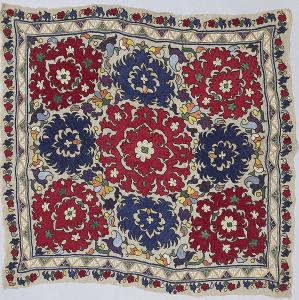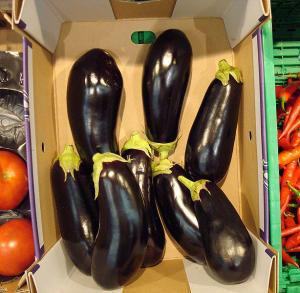Food for Thought
My Favorite North African Vegetarian Recipes
The cuisine of North Africa  Viktor Vasnetsov. The Flying Carpet (1880)(Algeria, Egypt, Libya, Morocco, and Tunisia) was influenced by the many peoples who settled there: African, Islamic, Arab, Berber, Ottoman, French, Italian and Spanish. It has its roots in the beginning of civilization itself.
Viktor Vasnetsov. The Flying Carpet (1880)(Algeria, Egypt, Libya, Morocco, and Tunisia) was influenced by the many peoples who settled there: African, Islamic, Arab, Berber, Ottoman, French, Italian and Spanish. It has its roots in the beginning of civilization itself.
In addition to use in bread and pastry dough, wheat, an important staple in North African cooking, is made into bulgur and couscous. Bulgur, or cracked wheat, is made by partially cooking the wheat grains in water, drying them, then breaking them into pieces. Couscous is semolina (mostly durum wheat or barley), rolled in flour to produce a cross between grain and pasta.
 The vegetarian tradition of North Africa makes use of a multitude of whole food ingredients: Honey, sesame paste (tahini), almonds, pistachios, and pine nuts are used in both sweet and savory recipes. Butter and clarified butter (called ghee in India) are traditionally the preferred medium of cooking for those who can afford them. Olive oil is prevalent in Mediterranean coastal areas. For better or worse, vegetable oils have lately replaced traditional oils because they are cheaper and considered healthier. Common spice mixtures include cinnamon, cloves, cumin, coriander, tumeric, salt, black pepper, bay leaves, caraway seeds, fenugreek leaves, paprika, thyme, saffron, nutmeg, and ginger. Chili peppers are used in a paste called harissa.
The vegetarian tradition of North Africa makes use of a multitude of whole food ingredients: Honey, sesame paste (tahini), almonds, pistachios, and pine nuts are used in both sweet and savory recipes. Butter and clarified butter (called ghee in India) are traditionally the preferred medium of cooking for those who can afford them. Olive oil is prevalent in Mediterranean coastal areas. For better or worse, vegetable oils have lately replaced traditional oils because they are cheaper and considered healthier. Common spice mixtures include cinnamon, cloves, cumin, coriander, tumeric, salt, black pepper, bay leaves, caraway seeds, fenugreek leaves, paprika, thyme, saffron, nutmeg, and ginger. Chili peppers are used in a paste called harissa.
Green leaf vegetables such as mint, parsley, many varieties of cabbage, spinach, and chard are used in abundance. Common root and bulb vegetables include potatoes, onions and garlic, as well as carrots, turnips, and beets. Cucumbers, squash, tomatoes, zucchini, and eggplant are the most common ingredients in vegetable stews and salads. Common fruits include lemons, oranges, apricots, figs, dates, and pomegranates. Green and black olives, and capers arrived in the area before the Romans. Commonly used legumes include fava beans, chickpeas, haricot beans, lentils, and split peas.
Milk, fresh or soured, is another important staple in North Africa. Yogurt, a Turkish contribution, is commonly consumed plain, used in cooking and in salad dressings, or diluted as a drink. White cheese, like the Greek feta, is made from sheep's or goat's milk. Eggs are also very important ingredients in savory cooking. Under the Ottoman Empire, dense, sweet coffee was brought to the area, and is now widely consumed throughout North Africa and the Middle East.
Tabouli
adapted from The New Moosewood Cookbook by Mollie Katzen
The name for this bulgur wheat and parsley salad, tabouli, translates as "little seasoning," and is derived from the Arabic word tabil.
 Algerian turban cover, Wikimedia Commons
Algerian turban cover, Wikimedia Commons
Ingredients:
1 cup bulgur wheat
1 1/2 cups boiling water
1 teaspoon salt
1/2 teaspoon pepper
juice of 1 lemon
1/4 cup olive oil
4 cloves garlic, minced
4 scallions, chopped
1 cup chopped parsley, packed
1/4 cup mint leaves, chopped
3 medium tomatoes, diced
1 can pitted black olives, chopped
Preparation:
Pour boiling water over wheat, cover with plastic wrap, and soak for 30 minutes. Stir in salt, lemon juice, oil, garlic, pepper, and scallions, and chill for 30 minutes. Before serving, mix in the rest of the ingredients.
Falafel
These chickpea fritters are traditionally deep fried. For a lighter, more delicate version, pan fry in almond oil. The word falafel comes from the Arabic falāfil, the plural of filfil which means "pepper," from the Sanskrit word pippalī, or "long pepper."
Ingredients:
2 cups dried chickpeas, soaked in water overnight
1 teaspoon baking powder
1 small onion, coarsely choppedArab restaurant, Egypt., NYPL Digital ID 88469
6 garlic cloves
1 tablespoon ground cumin
1 tablespoon ground coriander
1/4 teaspoon red pepper flakes
3/4 cup parsley, packed
salt and black pepper to taste
vegetable or almond oil, for frying
Preparation:
Drain, then pulse chickpeas in food processor to coarsely grind. Add baking powder, onion, garlic, spices, and herbs; process until mixture is pureed. Heat oil in frying pan or in deep fryer to 375 degrees. Roll falafel mixture into 1 inch diameter balls. Fry in deep fryer for 5 minutes. If pan frying, saute until brown on both sides. Drain on paper towels. Serve in pita pockets with lettuce, chopped tomatoes, hummus, baba ganoush, and tahini sauce and/or harissa.
Tahini Sauce
The English word tahini comes from the Arabic ṭaḥīnīa, and is derived from the verb "to grind." This extremely popular sauce is used in most North African sandwiches.
Ingredients:
1/2 cup tahini
1/2 cup low fat yogurt or water
juice of 1 lemon
2 garlic cloves, chopped
salt to taste
pinch hot paprika or cayenne
Preparation:
Combine all the ingredients in a food processor until creamy.
Harissa
adapted from The North African Kitchen by Fiona Dunlop
The word for the fiery Tunesian chili paste harissa is derived from the Arabic verb harasa, "to pound."
1 tablespoon coriander seeds
1 tablespoon caraway seeds
2 teaspoons cumin seeds
9 oz. fresh red chilis, roughly chopped
cloves from 1 head of garlic, peeled and roughly chopped
1 tablespoon dried mint
1/4 bunch fresh cilantro
1 tablespoon salt
2-3 tablespoons olive oil
Preparation:
Toast seeds in pan without oil for about 2 minutes. Grind to powder in spice grinder. Add this blend to rest of ingredients in a food processor, adding enough olive oil to make a stiff paste. Put in sterilized jar with a thin layer of olive oil over top; store in refrigerator.
Restaurant Style Hummus
adapted from Cook's Illustrated
The English word hummus comes from the Arabic ḥimmaṣ, meaning "chickpeas."

1/4 cup water
juice of 1 lemon
6 tablespoons tahini
2 tablespoons olive oil
1 15 oz. can drained and rinsed chickpeas
3 cloves garlic
salt to taste
1/2 teaspoon cumin
1/2 teaspoon Ras el Hanout
hot paprika
Preparation:
Combine water and lemon juice in one bowl, tahini and oil in another. Put chickpeas, garlic, salt, and spices in food processor and blend for 15 seconds. Scrape down sides of bowl, then add lemon/water mix and process for 1 minute. Scrape bowl down again, add oil and tahini with processor running and blend until hummus is fluffy. Transfer to plate orbowl, and spinkle top with paprika. Serve chilled or at room temperature.
Ras el Hanout
from Classic Vegetarian Cooking From the Middle East and North Africa by Habeeb Salloum
Ras el Hanout means "top of the shop." For North African souks, or spice merchants, it is a point of honor to have the most sought after version of this blend.
Ingredients:
1 tablespoon ground cumin
1 tablespoon ground ginger
1/2 teaspoon turmeric
1/2 teaspoon ground cinnamon
1 tablespoon black pepper
1 tablespoon ground coriander seeds
1/4 teaspoon cayenne
1/2 teaspoon ground allspice
1/2 teaspoon ground nutmeg
1/4 teaspoon ground cloves
1/2 teaspoon mace
1/2 teaspoon cardamom
Preparation:
Combine all ingredients. Store in an airtight container at cool room temperature.
Baba Ganoush
adapted from Williams-Sonoma's Small Plates by Joanne Weir
According to food legend, baba ganoush (which means "spoiled old daddy" in Arabic) was created by a doting daughter who delighted in pampering her toothless father. This dish tastes best when the eggplant is grilled to char the skin, then baked until soft in the oven. I have adapted this recipe for city kitchens. (If you like, you can char the eggplant's skin on a gas burner on your stove top, then finish it off in the oven. Be sure to use caution around an open flame!)
Ingredients:
1 large eggplant
1/4 cup tahini
juice of 1 lemonAuberginen im Supermarkt, Claus Ableiter, Wikimedia Commons
3 cloves garlic
salt to taste
1/2 teaspoon cumin
1/2 teaspoon Ras el Hanout
1 tablespoon olive oil
hot paprika
Preparation:
Pre-heat oven to 400 degrees. Score eggplant with a knife down its length at about 1 inch intervals. Wrap eggplant in aluminum foil and roast for one hour, rotating every 15 minutes, until eggplant is soft. Remove from oven and peel. Place cooled eggplant in food processor, add tahini, lemon, garlic, salt and spices and blend until smooth.Transfer to plate or bowl, and sprinkle top with paprika. Serve at room temperature.
Although not strictly vegetarian, these cookbooks are full of of delicious, healthy North African and Middle Eastern recipes.
- The Arabian Nights Cookbook: From Lamb Kebabs to Baba Ghanouj, Delicious Homestyle Arabian Cooking by Habeeb Salloum
- From the Land of Figs and Olives: Over 300 Delicious and Unusual Recipes From the Middle East and North Africa by Habeeb Salloum and James Peters
- The New Book of Middle Eastern Food by Claudia Roden
- Arabesque: A Taste of Morocco, Turkey, and Lebanon by Claudia Roden
- The North African Kitchen: Regional Recipes and Stories by Fiona Dunlop
Read E-Books with SimplyE
 With your library card, it's easier than ever to choose from more than 300,000 e-books on SimplyE, The New York Public Library's free e-reader app. Gain access to digital resources for all ages, including e-books, audiobooks, databases, and more.
With your library card, it's easier than ever to choose from more than 300,000 e-books on SimplyE, The New York Public Library's free e-reader app. Gain access to digital resources for all ages, including e-books, audiobooks, databases, and more.
If you don’t have an NYPL library card, New York State residents can apply for a digital card online or through SimplyE (available on the App Store or Google Play).
Need more help? Read our guide to using SimplyE.


Comments
So love this blog!!!
Submitted by Zena George (not verified) on March 30, 2012 - 6:12pm
Thanks, Zena!
Submitted by Sally (not verified) on April 2, 2012 - 8:18am
what is ras el hanout, and
Submitted by Anonymous (not verified) on April 1, 2012 - 11:17pm
Ras el Hanout is a spice blend
Submitted by Sally (not verified) on April 2, 2012 - 11:23am
indian recipes
Submitted by Indian Veg Recipes (not verified) on November 22, 2016 - 11:09pm